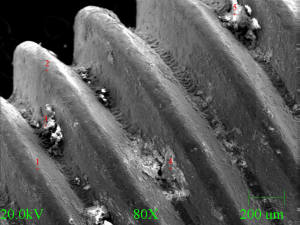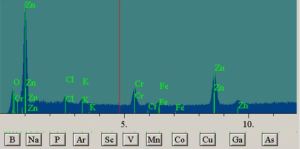Carbon and Sulfur Dioxide Attacking Buna-N O-rings
Gideon Analytical Laboratories received several screws to identify whether or not they were the source of carbon disulfide and sulfur dioxide, which were attacking some Buna-N O-rings. O-rings are a mechanical gasket in the shape of a torus; it is a loop of elastomer with a round cross-section, designed to be seated in a groove and compressed during assembly between two or more parts, creating a seal at the interface. The O-ring may be used in static applications or in dynamic applications where there is relative motion between the parts and the O-ring. Dynamic examples include rotating pump shafts and hydraulic cylinder pistons. Nitrile, also commonly referred to as Buna-N or NBR, is a copolymer of Acrylonitrile and Butadiene. Nitrile is the most commonly used elastomeric material for molded and extruded products. This material offers relatively low cost, good mechanical properties, and resistance to many common oils, fuels, and lubricants. NBR has poor resistance to weathering, sunlight, and ozone so it is best used in enclosed environments where parts are not exposed to the elements. For this job, the goal was to identify the source of the carbon disulfide and sulfur dioxide that was on the screws.
Failure analysis ensued. The screws were analyzed using SEM-EDS (energy dispersive spectrometry) to determine the elements present. There was a zinc potassium chromate coating on a steel shank. There was also chloride, which reacted with the potassium to form a weak salt. There was some kind of silica (dirt) or silicates which resided on the screw surface, and these materials were corroding the screw and the Buna-N O-rings. Gideon Analytical Laboratories concluded that the making of the zinc potassium chromate on the screw is not the source of the carbon disulfide which is causing the destruction of the Buna-N O-rings.
At Gideon Analytical Laboratories, we solve electronic problems. The reason why we are able to solve problems so accurately and quickly with such certainty is because we have an extensive background not just in electrical engineering, but in chemistry. The knowledge of those two inextricably linked sciences allows us to seamlessly integrate both disciplines into the problem-solving process. We can determine if the problems are electrical in nature like electrical overstress (EOS), or if they are chemical in nature, like chlorine or bromine contamination. We know the chemistry, and we know how chemical reactions are going to impact electrical circuitry. We know electricity; we know chemistry. Get in the flask lane and form your bond with Gideon Analytical Laboratories today and get solutions that work.

Micrograph of Screw 80x

SEM-EDS of screw